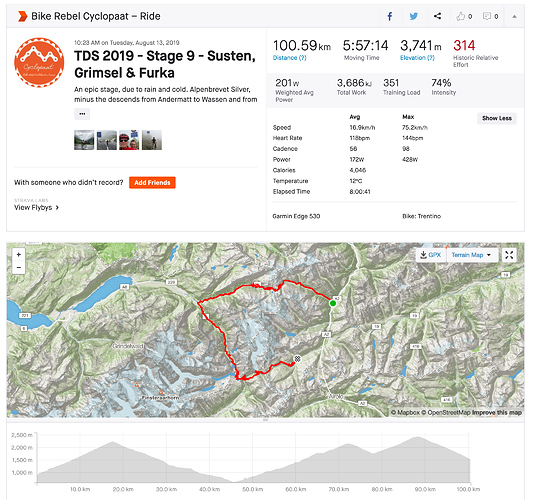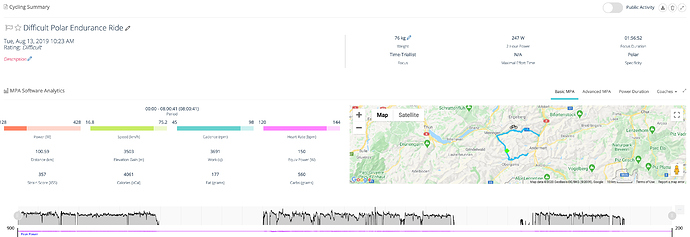Nobody is asking Xert to change its’ philosophy or the way it presents its’ metrics. It’s just that there are a number of people, and I’ve no idea how many, but I count myself amongst them that like, rightly or wrongly, to look at the amount of training time per week in the way that Garmin, TrainerRoad or Strava do. Unless there are resource issues in giving this info as well, then I really can’t see the point in not giving people the option of being able to see and monitor it. Unless of course there are only a handful of us in which case it would probably not be cost effective.
The data is in the stream and I don’t think it’s up to Xert to figure out how many people want it and question their need for it.
But it IS up to them to decide if they can squeeze it in, either on the ride details page and/or in the weekly stats, and if they are willing to do that.
If that’s too much of a hassle, just say so/no, don’t rationalize it with it being an useless metric.
Okay the Tesla analogy may be invalid.  What I was trying to say was showing a traditional gas gauge on a Tesla dashboard, such as 1/4 tank left, would have little or no value in calculating miles-to-go before charging. The Tesla design engineer would nix the idea as superfluous and irrelevant.
What I was trying to say was showing a traditional gas gauge on a Tesla dashboard, such as 1/4 tank left, would have little or no value in calculating miles-to-go before charging. The Tesla design engineer would nix the idea as superfluous and irrelevant.
Here’s another analogy attempt. Go ahead and knock it if you want  –
–
Consider a trio of fitness apps calculating energy expended using your wristband tracker.
The two older apps count steps per day in their calculations.
The new app tracks footfalls whether you are standing still, marching in place, or stepping forward.
Customer: Can you please show me steps in your new app?
App developer: We don’t count steps or use that metric in our calculations.
Customer: Okay, but I need to know steps because I have always counted steps.
Perhaps those who desperately want this stat should appeal to the “marketing dept”.
Make the request an incentive.
“I will considering subscribing to your service but only if you show me steps counted.” 
How is moving time normally derived?
Do Garmin and Strava extrapolate the number strictly based on GPS data?
If derived then auto-pause on your GPS shouldn’t really affect the number or does it?
Is the required data in every FIT file including rides recorded by the Xert apps?
If Xert decides to add it there should be a tool tip ? next to the number explaining that it’s not used in any calculations. Or link to all the forum posts arguing about it. 
I’m not sure anymore who’s overthinking this, but it’s ASAF: whether you like it or not, whether you use it or not in any of your calculations, if people want/need it and ask for it, you can either deny or approve the request.
Do not use your logic (Xert’s) to tell people they don’t need it. Absolutely do not give in to any and all demand for stuff, but this is a simple thing to add.
About demand: check intervals.icu or Elevate to see what people ask for and how it is dealt with. And those are free platforms, depending on voluntary contributions. And yes, I do make those.
For Garmin, it’s based on moving speed or you pressing pause. Moving speed threshold can be set, like < 5 kph - I’ve set it to < 2 kph, because otherwise, it may still keep recording, if you take it with you when you walk to the terrace. The standard < 10 kph frequently auto-paused my Garmin, when I was working my way up Monte Zoncolan ![]()
Hmm… never thought about the issue of climbing walls and the auto-pause setting.
What if you zigzag up a steep climb?
Is the speed threshold based on wheel speed or movement calculated by your GPS track?
I’ve seen moving time on Garmin and Strava of course but never paid much attention to it.
If I’m out for 5 hours on a weekend ride that’s a 5 hour ride in my book no matter how many snack and pee breaks I take. Elapsed time is just alright with me. Perhaps that’s old school thinking.
I can see why stopping for a 3 course lunch with your Garmin left on will create an issue for some. 
To each their own ![]() Lots of people, including me, would like to know their actual ‘active time’, like for compliance to plan reasons.
Lots of people, including me, would like to know their actual ‘active time’, like for compliance to plan reasons.
Or, look at the Strava and Xert recording of the same ride - it’s probably just vanity, but NP and XEP are way different, not only because of the descends, but also the breaks at the summits. In this case, NP is telling me more than XEP, even if it would be the least important number.
We agreed we were not going to fiddle with the math, it was about the moving versus elapsed time, but anyway…
Speed is based on GPS, which means that under some circumstances, ranging from thick overhead leaves, tunnels and even very bad weather, there are errors. But these are corrected when the ride is uploaded to Garmin Connect or Strava, when they calculate speed for time moving against the distance measured.
Same goes for elevation btw.
I suppose zigzagging up a steep climb could (marginally) influence distance, but on narrow climbs like the Mortirolo and Zoncolan, there’s is not a lot of moving space, so it won’t matter much. Probably also something that gets corrected when uploading.
If you stop moving, the timer will still continue, so this ensures that your ‘catching your breath’ breaks on a (steep) climb, will not make you faster for the Strava segments, as they actually use elapsed time for that.
I realized afterwards that it was actually the other way around and I checked my Garmin - it is set to < 7 kph, which means I will be able to take it with me, while walking, and I have yet to find a climb where I will move slower than that, without toppling over anyway ![]()
Epic ride! The first half would have been plenty for me.
I see how and why you and many others have a different spin on this issue.
“compliance to plan” and “NP and XEP are different” aren’t things I care about anymore.
I’ve dropped the cookie cutter plans, the spreadsheets, the multiple subscriptions, the train-by-power books, 5-6-7 zone analysis, SST, etc. and trying to keep everything in sync. 
I’m treating Xert as the unplanner solution to getting fit on a bike. I had a couple of false starts being entrenched on other platforms but I recently let the others go. I don’t miss them.
Now I set a target date, mostly follow suggested workouts between phases, then rinse and repeat as the seasons change.
I don’t dig too deep into the numbers or worry about a weekly or monthly plan per se.
I review suggested workouts for the day and pick one or use filters to go off-script whenever I feel like it and want a challenge or need to dial it down. Sometimes I skip days in a row.
I monitor the XPMC chart for trends and milestones and occasionally link through to Strava for a different viewpoint. My Garmin Connect stats have fallen by the wayside.
As you say to each their own. As the decades slip by your focus changes. 
I’ve settled on Xert even if it’s an imperfect evolving model. I like their approach and the results work well for me. I think simplifying a few things would garner more market share but that’s another discussion.
As to the topic at hand, maybe I’m starting to elapse in judgement. 
I hear you and there’s not much I disagree with. I use Xert much in the same way, but it’s not a one-stop solution. I’m not comparing, but I do use intervals.icu to get insights Xert is not offering.
Furthermore, I have a hard time using Xert to work towards a trip to the Alps - that ride was just 1 of 10 in 11 days.
It’s excellent for using towards a 40K ITT on day x, but these trips of mine are different.
Other than the occasional ITT, I ride gran fondo’s, which often are every weekend. Obviously not in these times, or at least not organized.
And yes, things change as decades go by - not sure about how many you’ve seen, but I’ll turn 60 in July.
So, also that is something why I have previously considered I’m not in a primary target group for Xert.
But, we’re diverting - we just need the moving time counter 

